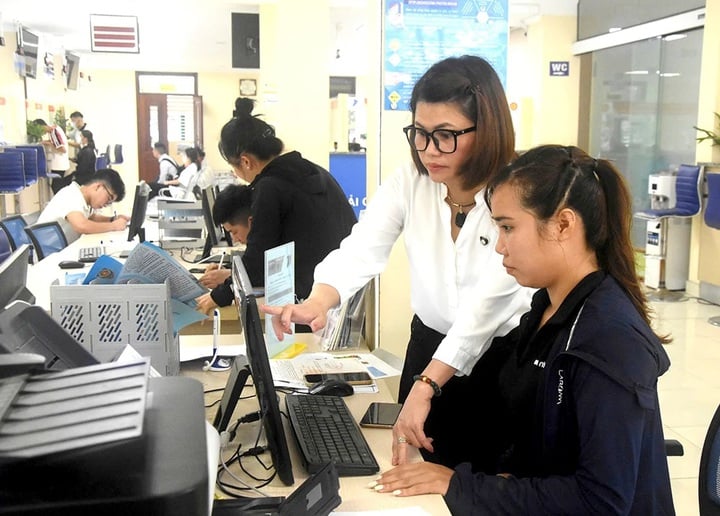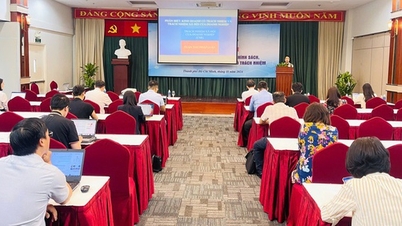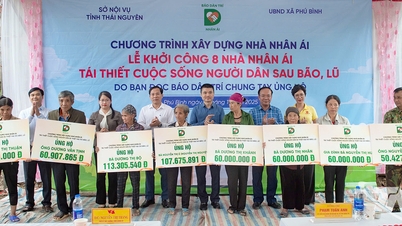The digital divide remains large
In Muong Te commune ( Lai Chau ), Mr. Ly A Cho said: For the past few years, my family has had a smartphone, but the signal is weak, sometimes it is available and sometimes it is not. I don't know how to use many services such as submitting administrative documents online or paying via QR, I have to go to the commune center to ask the staff for instructions.
Mr. Cho's story is not an isolated one. In many mountainous areas, telecommunications infrastructure and people's information technology level are still the biggest barriers. According to data from the Ministry of Information and Communications , by the end of 2024, the rate of households in remote areas with Internet access was only about 65%, much lower than the national average of over 90%.
In addition, terminal devices are limited. Many households still use regular phones or old smartphones, which are not capable of installing and using applications for digital transformation. This makes it difficult to popularize digital platforms to each citizen.
Lack of digital skills - a soft but difficult barrier to overcome
If infrastructure is a physical barrier, digital skills are a "soft knot" that is difficult to untie.
The reality of implementing online public services shows that many people, especially the elderly or ethnic minorities, are not familiar with using technology. They are afraid of making mistakes and are reluctant to operate. There are cases where commune officials have given instructions many times but people still prefer to submit paper documents.
These people are "lacking skills" or "afraid to learn new things" when using digital platforms. Deeply aware: "Digital transformation starts from the people, with people as the center, the subject, the goal, the driving force and the driving force of digital transformation" - that's why the community digital technology group model was born with the mission of supporting people to access and use digital technology in a simple way, based on natural needs, creating practical values for people, bringing digital technology into every corner of life.

Officials guide people to use online public services at the Phu Tho Provincial Public Administration Service Center.
The community digital technology team is a unique and national approach of Vietnam and is the premise for drastic approaches, creating breakthrough results in digital transformation in the future. From a single development model at the local level, the community digital technology team has now formed a nationwide network. Up to now, 100% of communes and wards across the country have established community digital technology teams with more than 93,524 community digital technology teams at the village, residential group, residential area, hamlet, and 457,820 units forming a nationwide network, providing practical and effective support for the national digital transformation work.
This shows that propaganda and training on basic digital skills still need to be carried out regularly, flexibly and closer to the people.
Language and living habits - factors that need special attention
In many highland areas, the language barrier is also a major challenge.
Ms. Vang Thi Do, a resident of Nam Ban commune (Dien Bien) shared: Officials talk a lot about "online public services" or "digital transformation", but I don't understand everything. If there were instructional videos in ethnic languages, it would be easier.
Currently, many localities have initially digitized propaganda information in bilingual or organized training classes in ethnic languages, helping people better understand the benefits of digital transformation. However, the scale is still small and not uniform.
This shows that digital transformation is not only a story of technology but also a story of culture. When people feel that digital applications are close and connected to their daily lives, they will actively accept them.
In fact, there have been many models of people applying digital technology in life such as: knowing how to livestream to sell agricultural products (honey and dried bamboo shoots...); using Zalo to connect with traders; looking up land documents through the public service portal... Those changes, though small, are creating a new wave of "digital culture" in the highlands.
Currently, the community technology team model includes commune officials, youth union members, young teachers... whose task is to guide people in using public services, e-commerce, digital payments, registering QR codes to sell agricultural products...
However, these groups are also facing many difficulties such as limited operating budget, limited instructional materials, and many applications change rapidly, so they have to constantly relearn.
Experts believe that there should be regular support policies for these forces, considering them an important "bridge" between the state and the people in the digitalization journey. To narrow the digital gap, it is necessary to synchronously deploy many solutions:
Investing in telecommunications infrastructure, 4G/5G coverage to 100% of villages: The State and telecommunications enterprises need to coordinate to promote investment in network infrastructure, have a mechanism to support disadvantaged areas, prioritize the installation of signal transceiver stations in areas with low signal strength; popularize basic digital skills for people.
Organize digital transformation classes in villages, schools, and cultural centers; integrate digital transformation content into curriculum and community activities; Develop digital content that is "close to the people and easy to understand". There should be instructional videos in ethnic languages, illustrated with real-life situations (for example: selling agricultural products online, submitting land records online...).
Support for equipment and preferential packages: Technology and telecommunications businesses can implement the "Smartphone for highland areas" program or cheap data packages to encourage people to use the Internet; Develop digital products suitable for regional characteristics.
For example: e-commerce platform supporting the sale of local specialty agricultural products; application for managing cooperatives, small cooperatives...
Digital transformation is only successful when everyone can access and benefit. The goal is not just to build an e-government or digital economy, but a digital society - where every person, whether in urban or mountainous areas, has the opportunity to participate and develop./.
According to Vietnam Science and Technology Magazine
Source: https://mst.gov.vn/nhan-dien-rao-can-de-nguoi-dan-vung-cao-tiep-can-chuyen-doi-so-197251109191311029.htm





![[Photo] Chu Noodles - the essence of rice and sunshine](https://vphoto.vietnam.vn/thumb/1200x675/vietnam/resource/IMAGE/2025/11/11/1762846220477_ndo_tl_7-jpg.webp)

![[Photo] Prime Minister Pham Minh Chinh receives Lao Minister of Labor and Welfare Phosay Sayasone](https://vphoto.vietnam.vn/thumb/1200x675/vietnam/resource/IMAGE/2025/11/11/1762872028311_dsc-2246-jpg.webp)















































































![Dong Nai OCOP transition: [Article 3] Linking tourism with OCOP product consumption](https://vphoto.vietnam.vn/thumb/402x226/vietnam/resource/IMAGE/2025/11/10/1762739199309_1324-2740-7_n-162543_981.jpeg)








Comment (0)